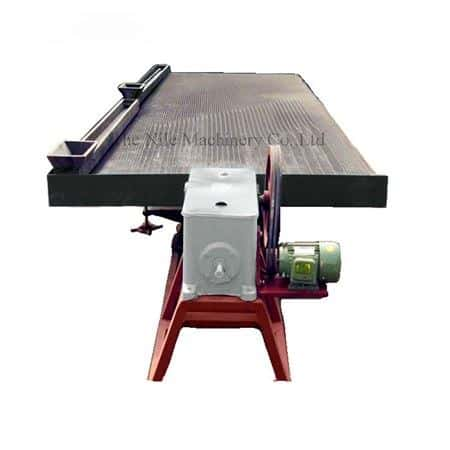

Products
Home > Products > Mineral Processing Equipment > Shaking Table
Processing Materials: Gravity concentrating tables are widely used in the separation of tin, tungsten, gold, silver, lead, zinc, tantalum, niobium, chromium, iron, manganese, ferro-titanium and coal. Nile Machinery has long history in producing gravity concentrating tables with high processing capacity, high recovery rate, high enrichment ratio and more competitive price. Gravity concentrating tables are effective in processing precious metal, rare metal and non-metallic minerals.

Working Principle of Gravity Concentrating Tables
The pulp is sent to the mine tank of gravity concentrating table, and water is added to prepare a pulp with a concentration of about 25% to 20%. It automatically flows to the bed surface, and the ore particles are loosened and stratified by washing in the bed groove and vibration of the bed surface. The upper light mineral particles are pushed by the larger water flow and move laterally along the bed surface and become tailings directly discharged. The heavy mineral particles at the bottom of the bed of gravity concentrating table are vibrated by the bed surface and move to the opposite side of the transmission end to form a concentrate, which is discharged from the concentrate end. The specific gravity and particle size of the ore particles are different, and the direction of movement is also different, so the group of ore particles starts to fan out along the diagonal from the feed trough. The product is discharged along the edge of the bed, and the discharge line is very long, so the shaker can accurately produce a variety of products with different qualities.

Influencing Factors of Gravity Concentrating Tables
1. Asymmetry motion of the concentrating table.
2. Water volume, stroke, and slope.
3. Feeding volume and concentration.
4. Feed size and shape.
Model NO. | 6S | Tbele Size | 4520*1850*156mm | |
Stroke | 8-36mm | Motor Power | 1.1kw | |
Time/min | 240-380 | Dimension | 5630*1850*900mm | |
Landscape | 0-5° | Table Weight | 650kg | |
Material | Feeding Size | Mine Density | Flushing Water | Capacity(t/h) |
Coarse Sand | 2-0.5mm | 10-30% | 0.5-3.5t/h | 1-2.5 |
Fine Sand | 0.5-0.074mm | 0.8-1.2 | ||
Ore Mud | 0.0774-0.037mm | 0.3-0.6 | ||